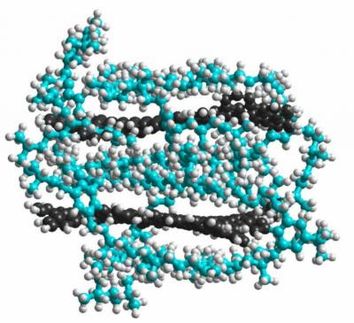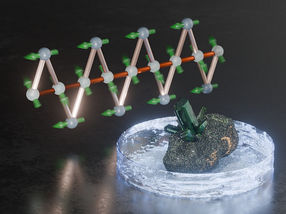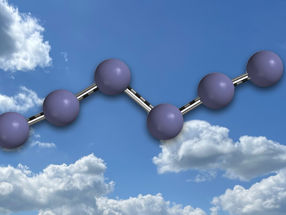Hydrogen advances graphene use
Physicists at Linköping University have shown that a dose of hydrogen or helium can render the "super material" graphene even more useful.
Graphene has engendered high expectations whereof its extreme properties depend on the fact that it consists of a single sheet of carbon atoms. However the attraction forces between the atoms cause the sheets to be drawn to each other. One solution is to add atomic hydrogen between the layers.
Presented in the eminent journal Physical Review A, the researchers' calculations show that the hydrogen at a given concentration affects the atomic van der Waals forces and becomes repulsive instead of attractive. The result is that graphene sheets repel each other and float freely just a few nanometres apart (an example of the so-called quantum levitation).
Professor Bo E. Sernelius, who conducted the study in conjunction with his former doctoral student Mathias Boström, identifies several possible applications of the discovery:
- Storage of hydrogen as vehicle fuel
- Creation of a single graphene sheet by peeling them from a pile that has grown on a substrate of silicon carbide; a method developed at Linköping University
- Repulsive forces are ideal for the manufacture of friction-free components on a Nano scale, for example, robots and sensors for medical purposes.
In the present study the researchers began with two undoped sheets of graphene on a substrate of silicon dioxide (silica). The starting position is the van der Waals attractive forces and the sheets are compelled closer together. However once atomic hydrogen is added, repulsive forces arise. A similar effect was observed using other gases such as molecular hydrogen (H2) and helium.
Graphene is a two-dimensional material, which means that it retains a very special character. It is flexible, transparent, stronger than a diamond and has a superior ability to conduct electric current. In 2010 André Geim and Konstantin Novoselov received a Nobel Prize in Physics because for the first time ever they succeeded in producing stable flakes of material.
Original publication
Repulsive van der Waals forces due to hydrogen exposure on bilayer graphene by Mathias Boström and Bo E. Sernelius. Physical Review A 85:1, 11 January 2012.
Most read news
Other news from the department science

Get the chemical industry in your inbox
By submitting this form you agree that LUMITOS AG will send you the newsletter(s) selected above by email. Your data will not be passed on to third parties. Your data will be stored and processed in accordance with our data protection regulations. LUMITOS may contact you by email for the purpose of advertising or market and opinion surveys. You can revoke your consent at any time without giving reasons to LUMITOS AG, Ernst-Augustin-Str. 2, 12489 Berlin, Germany or by e-mail at revoke@lumitos.com with effect for the future. In addition, each email contains a link to unsubscribe from the corresponding newsletter.




























































